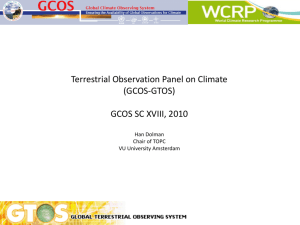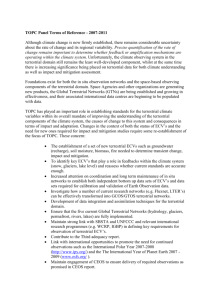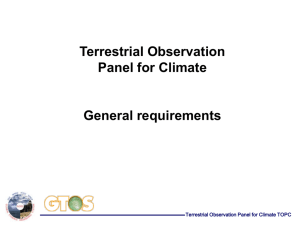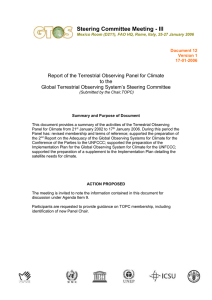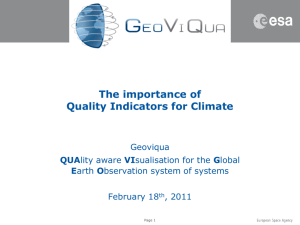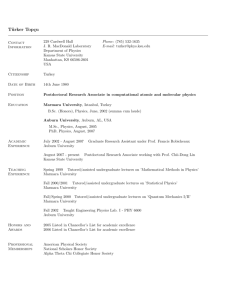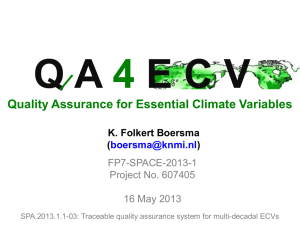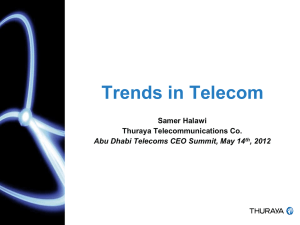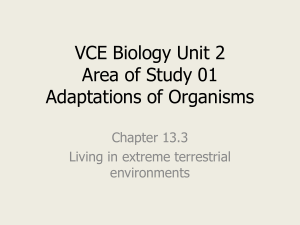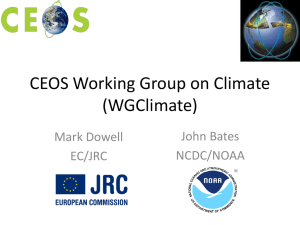TOPC
advertisement
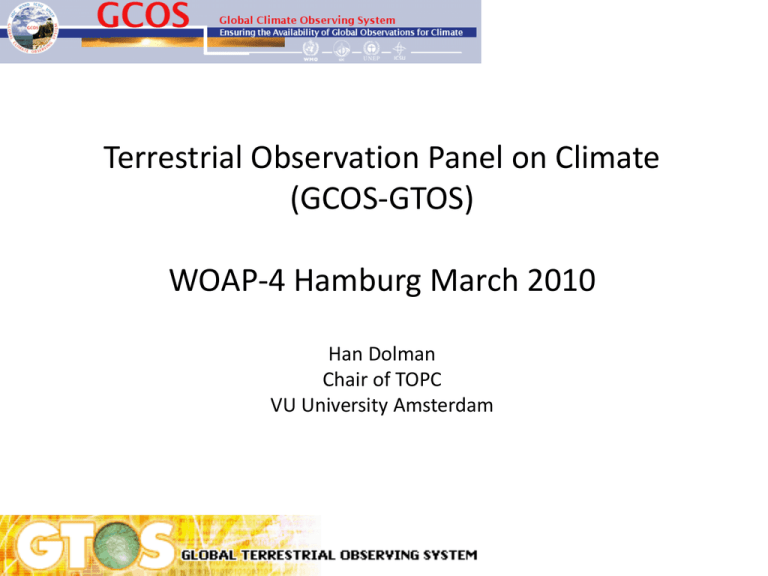
Terrestrial Observation Panel on Climate (GCOS-GTOS) WOAP-4 Hamburg March 2010 Han Dolman Chair of TOPC VU University Amsterdam TOPC activities • • • • • • • Contributing to GCOS progress report Contributing to GCOS-IP GCOS-GTOS secretariat input Input WCC-3 white paper GEO carbon tasks Developing standards and guidelines Members involved with specific GTN’s Progress on the land GCOS-Progress report Terrestrial progress • There has been significant progress in defining internationally accepted standards for the terrestrial ECVs (move to wards ISO standardization). • Progress in establishing institutional support for in situ networks has been slow, • The objective of creating a comprehensive and well coordinated reference network for in situ observations of the fullest possible range of terrestrial ECVs is a continuing, yet still a largely unmet challenge • The establishment of several Global Terrestrial Networks (GTNs) in a number of areas (e.g. Hydrology, Glaciers, Permafrost), where data collection takes place largely through in situ measurements has significantly improved the coordination and global coverage of these observations Terrestrial progress Observations taken for purposes other than climate, but with climate relevance, are often not made available,. • Good progress has been made in guaranteeing short-term continuity in the availability of high-resolution optical observations from satellites,. • The increasing commitment of space agencies to produce fundamental climate data records from existing systems has led to improved availability of global datasets, such as burned area and land cover. • The analysis of historical records, both in situ and satellite based, has been progressing slowly and needs the urgent consideration of space agencies together with the potential users. Action T12 • Action: Develop Global Terrestrial Network on Soil Moisture • Who: Parties’ national services and research programmes, through IGWCO, GEWEX and TOPC in collaboration with space agencies. • Time frame: 2012 • Performance indicator: Fully functional GTN-SM with a set of in situ observations (possibly co-located with reference network, cf. T3), with standard measurement protocol and data quality and archiving procedures. • Annual Cost Implications: 1-10M USD (40% in non-Annex-I Parties). Action T11 • Action: Develop a record of validated globally gridded near surface soil moisture from satellites • Who: Parties’ national services and research programmes, through GEWEX and TOPC in collaboration with space agencies. • Time frame: 2014 • Performance indicator Availability of globally validated soil moisture products from the early satellites until now. • Annual Cost Implications: 1-10M USD (10% in non-Annex-I Parties). Status • Satellite soil moisture is top few cm only • In situ networks – Rutgers University (Chinese, Russian data) – Univ. Vienna (ESA) just set up • There is no ECV documentation on standards and guidelines • Organize small workshop with modelers, assimilators (GEWEX) with ESA? Action T4: Develop an experimental evaporation product from existing networks and satellite observations Who: Parties, national services, research groups through GTN-H, IGWCO and TOPC Time frame: 3-5 years Performance indicator: Availability of a validated global satellite product of total evaporation Annual Cost Implications: 1-10M USD (10% in non-Annex-I Parties). Global Interception loss Mirrales et al., 2010 • While we have a number of satellite ECV products, like albedo, Fapar etc., their validation is generally poor • We need to find a mechanism to get our set of 35 global reference sites (linked with Fluxnet) and CEOS Cal-Val, similar to GRUAN Action T3 [IP-04 T3, T29] • Action: Development of a subset of current LTER and FLUXNET sites into a global reference network for ecological monitoring sites with sustained funding perspective. • Who: Parties’ national services and research agencies, FLUXNET organizations, NEON, ICOS, in association with CEOS WGCV, CGMSGSICS, GTOS (TCO and TOPC) • Time-frame: Implementation by 2010 • Performance Indicator: Plan for the development and application of standardized protocols for the measurements of fluxes and state variables • Annual Cost Implications: 30-100M USD (40% in non-Annex-I Parties). • See also Actions A15, A27, A30. • Reference is made to corresponding (not necessarily identical, often follow-on) Actions in the IP-04, so they exist. A Global Carbon Tracking System: Supporting Society’s Important 21st Century Decisions • Key driver of current Carbon CoP activities • Goal to evaluate progress and future direction for global carbon observing system • More emphasis on data integration systems and implementation • GCOS (AOPCC, TOPC, FAO, WMO) involved Action T33 • Action: Develop globally gridded estimates of terrestrial carbon flux from in situ observations and satellite products and assimilation/inversions models. • Who: Reanalysis centres, research organisations, in association with national institutes, space agencies, FAO/GTOS (TCO and TOPC) • Time Frame: 2014-2019 • Performance indicator: Availability of data assimilation systems, and global time series of maps of various terrestrial components of carbon exchange (e.g. GPP, NEP, NBP) • Annual Cost Implications: 10-30M USD (Mainly by Annex-I Parties). Joint AOPC/TOPC/OOPC working group • The GCOS IP is organized by disciplines, yet • Some ECVs are intrinsically joint properties of two geophysical media, e.g., surface albedo is a joint property of the surface and the atmosphere • The estimation of some ECVs depends on the values of other ECVs in different domains, e.g., the retrieval of continental and marine variables depends on the accuracy of the atmospheric characterization • The IES/JRC has organized occasional workshops to deal with these interdisciplinary issues • The 1st joint working group, in 2007, addressed the issue of simultaneously estimating aerosol properties and surface albedo • This 2nd joint working group, in 2009, looked at the feasibility of assessing the Net Primary Productivity (NPP) of the biosphere globally and consistently across the land/ocean boundary TOPC and WOAP • Are the ECV products tuned to climate models, can they be used as input or benchmarks? • How can we optimize their use? • TOPC-Clic link, through Konrad Steffen/Richard Armstrong. Need to be stronger? • Consistent production of ECV’s across domains
